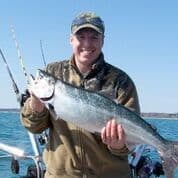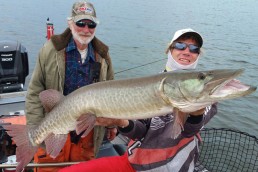Clean, Drain, Dry Initiative Continues Fight
SHARE THIS POST
It is no secret that throughout Michigan many aquatic invasive species continue to threaten rivers, streams and lakes.
Ruffe and round goby, Eurasian watermilfoil, curly-leaf pondweed and purple loosestrife are only a handful of the exotics that exist. But according to Seth Herbst, a DNR Fisheries biologist, sea lampreys, along with zebra and quagga mussels, have had the most significant impact on fish populations in Michigan. “Zebra and quagga mussels are a devastating invasive species that have caused major ecosystem shifts in the Great Lakes,” Herbst said. “Zebra mussels are very effective filter feeders and have the ability to remove much of the native plankton community, which is the primary productivity for our lakes. There have been studies that have documented changes in the plankton community after the introduction and establishment of zebra mussels.”
Plankton, which consists of small organisms that float and drift, is the primary food source for many fish in the Great Lakes. Since the completion of the Erie Canal, the sea lamprey continues to be a problem.
“Sea lamprey will attach themselves to the body of fishes with their suction disk mouth that has rasping teeth and will feed upon the blood and body fluids of fish. On average, an individual sea lamprey will eat approximately 40 pounds of fish during their parasitic stage,” Herbst said.
So what can one do to prevent the spread of these invasive species to other water sources? The answer is simple according to Herbst:
“Clean, drain, dry,” he says. “Clean, Drain, Dry (Initiative) is an outreach campaign that DNR Fisheries and others are using to increase awareness of how to prevent the spread of AIS. The message itself is related to recommended actions that boaters/anglers should take after every trip on the water.”
Herbst went on to say boaters should clean their boat of any vegetation, mud, or other debris because many AIS can become attached to the boat, survive and then be spread or transported to another water body. “Boaters should drain all of the water from their boat. This includes water that might be in the bilge,
livewell, storage compartments and access water that might be in the outboard,” he said.
Are you enjoying this post?
You can be among the first to get the latest info on where to go, what to use and how to use it!
Because many of the invasive species are microscopic, they can live in that excess water for long periods of time and be transferred to another body of water.
“Boaters should dry their equipment for up to five days because this has been shown to be effective at killing AIS.”
Although not included as part of this campaign, there is another step to perform when loading a boat.
“The other important action is to properly dispose of unused live bait in the trash and not release them into a water body, which could potentially introduce an AIS or fish diseases,” Herbst stressed.
Not only is transporting these species to other bodies of water harmful to the ecosystem, but it is also against the law. According to the Michigan Clean Boats and Clean Water Initiative, the state’s AIS volunteer program in 2009 passed a law prohibiting a person from placing any boat, boating equipment or boat trailer in Michigan waters with aquatic plant material attached, including all types of aquatic vegetation, and not just invasive species. A violation can result in a fine up to $100, and gives law enforcement officers the authority to “order the removal of aquatic plants from boating equipment.”
This fishing and boating season, take the extra time to follow the steps described in the Clean, Drain and Dry Initiative. Be sure to remove all aquatic plants from your boat and trailer.
“Observance of Clean, Drain, Dry principles by boaters and anglers, and participating in programs such as Clean Boats, Clean Waters, is critical for preventing the spread of aquatic invasive species between water bodies,” said Kevin Walters, an aquatic biologist. “Taking a few minutes to inspect and decontaminate your boat, trailer, and recreational gear can go a long way toward protecting Michigan’s lakes, rivers and wetlands and reducing future impacts from invasive species.”
MWO
SHARE THIS POST
Did you enjoy this post?
You can be among the first to get the latest info on where to go, what to use and how to use it!
Darin Potter
Darin Potter’s passion for outdoor writing began at the age of 12 when he first began writing in a journal that his parents bought him on a family camping trip in Northern Michigan. His writings have appeared in several Midwest publications: Michigan-Out-of-Doors, Michigan and Ohio Outdoor News, Modern Pioneer, and MidWest Outdoors.


